Caryn’s Thoughts
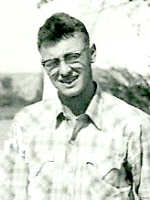
 My husband, Bob Schulenberg’s uncle, Butch Hein served in the US Navy during the Vietnam War. In all the years I have known him, and like most other veterans, Butch never talked about his time during that war. I don’t know where he spent his service years, but the main thing is that he made it home. Once home, Butch began to live the rest of his life.
My husband, Bob Schulenberg’s uncle, Butch Hein served in the US Navy during the Vietnam War. In all the years I have known him, and like most other veterans, Butch never talked about his time during that war. I don’t know where he spent his service years, but the main thing is that he made it home. Once home, Butch began to live the rest of his life.
He married the love of his life, Bonnie Wertz, and together they began planning their future lives. Bonnie soon became pregnant with their first child, and on November 5, 1969, their son, Scott was born. Life was perfect…for a time, but unfortunately it would not stay that way for long. While pregnant with their daughter, Crista, Bonnie was diagnosed with cancer. Like most mom’s she tried to wait it out, so she could give their daughter life, but in the end, both were lost. Butch’s heart was broken, and while he tried to move on with his life, and succeeded with his son, he really was never happy in a relationship again. Bonnie was his forever love. Nevertheless, Butch is very happy with his son. They are best friends and business partners in the ranching business they own together.
Scott grew up and married Terri Wiederrick. They now have three grown children, Laura, Carson, and Lindsey. Butch’s life has made a wonderful turnaround. Having these three grandchildren has been the highlight of his life. Scott built his house on the same property as his dad, so for much of the kids’ lives, they were right beside their grandpa. It was one of the greatest gifts Scott and Terri could have given his dad. Butch has been able to be a big part of his grandchildren’s lives, and they all love him very much.
Now that they are grown, the grandchildren are moving on with their lives. Laura is a teacher and lives a few hours away, Carson is working on a ranch in the area, and Lindsey is away at college. I think the empty nest 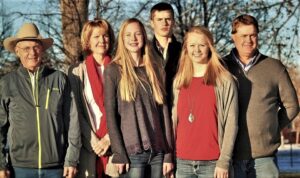
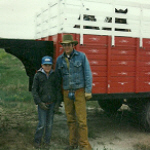 syndrome might apply not only to their parents, but to their grandpa as well. That happens when the grandparents are very close. It happened to me when my own grandchildren became adults, and while we are still close, it is more from a distance these days. I have a feeling Butch is finding himself in the same place. Happy, but a little sad too. Today is Butch’s 77th birthday. Happy birthday Butch. Have a great day!! We love you!!
syndrome might apply not only to their parents, but to their grandpa as well. That happens when the grandparents are very close. It happened to me when my own grandchildren became adults, and while we are still close, it is more from a distance these days. I have a feeling Butch is finding himself in the same place. Happy, but a little sad too. Today is Butch’s 77th birthday. Happy birthday Butch. Have a great day!! We love you!!
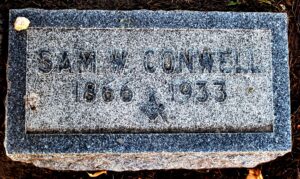
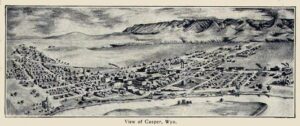 In a city, there are sometimes people who become the influencers of the community. These people are the ones who shape the city into what it is today. These people are considered the “pillars of the community” and are well liked and respected. Many of the city’s most influential people have streets, parks, and even buildings named after them to honor them.
In a city, there are sometimes people who become the influencers of the community. These people are the ones who shape the city into what it is today. These people are considered the “pillars of the community” and are well liked and respected. Many of the city’s most influential people have streets, parks, and even buildings named after them to honor them.
In Casper, Wyoming, where I live, that “pillar of the community” was a man from Iowa named Samuel W Conwell. Conwell was that “man about town” socialite who was well liked and respected. He really cared about his adopted community, and he helped to shape it into the city it is today. The people of Casper totally agreed that Samuel W Conwell was an amazing influencer in Casper, so they named a 19-block street after him. Conwell Street begins at the East 1st Street intersection where Conwell Park is located. Conwell was born on June 26, 1866, in Iowa, the Hawkeye State, but he moved to Casper around 1895 and immediately began to make his mark on our little town. Over the next four decades, he worked at a number of jobs, including as cashier at the Richards and Cunningham Bank and the Casper National Bank, and later he was the Secretary-Treasurer for the Nicolaysen Lumber Company. Samuel Conwell was a man who wore several hats in his life. He was also an early Casper Fireman.
Some of his other notable milestones achieved while living in and influencing the growth and progress of Casper include serving on high school and district school boards for three decades and helping to build the high school (now known as Natrona County High School, as well as shaping Casper’s educational progress during his time on those boards. Conwell was a county commissioner from 1911-1914. In addition to being a fireman Conwell helped organize the Casper Volunteer Fire Department and then served as its Chief, too. He was the past president of the Casper Chamber of Commerce, and also served as chairman of its traffic committee. In 1921, he was appointed by Governor Carey to the State Highway Commission, where he served the rest of his life. His many contributions to our community, definitely earned him the honors he was later given.
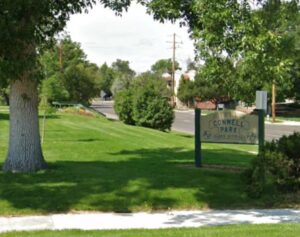

After a long illness, Samuel Conwell died at his home on 241 West 9th Street, on January 31, 1933, at the age of 66. Conwell Street and Conwell Park were not names given randomly by the developer who was just trying to come up with the names, but rather they are names given to represent a pillar of the community, and a man whose spirit lives on in the city.

 On June 24, 2022, my nephew Garrett Stevens and his wife, Kayla were blessed with their second beautiful daughter, Maya June Stevens. Maya joins big sister, Elliott Stevens, who is so excited about having a little sister…and now they are four…just like that. Maya arrived by Cesarian Section at 8:00am at the Sheridan Community Hospital. She weighs 7 pounds 11 ounces, and she is 20 inches long. While her big sister has blonde hair, like her daddy did; it looks like Maya might have brown hair like her mommy…and it’s a little thicker on top, which is common with darker hair. Elliott’s hair started to show its curls around the time she was 5 or 6 months old, so we will see if Maya gets those same beautiful curls.
On June 24, 2022, my nephew Garrett Stevens and his wife, Kayla were blessed with their second beautiful daughter, Maya June Stevens. Maya joins big sister, Elliott Stevens, who is so excited about having a little sister…and now they are four…just like that. Maya arrived by Cesarian Section at 8:00am at the Sheridan Community Hospital. She weighs 7 pounds 11 ounces, and she is 20 inches long. While her big sister has blonde hair, like her daddy did; it looks like Maya might have brown hair like her mommy…and it’s a little thicker on top, which is common with darker hair. Elliott’s hair started to show its curls around the time she was 5 or 6 months old, so we will see if Maya gets those same beautiful curls.
While Kayla and Maya needed to stay in the hospital for a day or so, and Garrett stayed with them, Elliott is back at home, for a while anyway, with her grandparents. That means that Garrett and Kayla have some alone time with Maya. I think that might be a good thing, because Elliott is sure that Maya is her baby!! She wants to hold her all the time when she is with her. I think that Garrett and Kayla may have a fight on their hands for a while…not a real fight, of course, but at least until the newness wears off, Elliott may want to hold “her baby” all the time.
Maya is such a sweet little baby. She doesn’t fuss very much, and she is fine with being passed from person to 
 person, including her big sister. She rather enjoys all the attention, which is very nice for all concerned. She loves her big sister, and especially likes it when Elliott sings to her. Elliott has been singing her the ABCs song and Baa Baa Blac Sheep. I know that Elliott is going to be a great “Mommy’s Helper” because she is already so comforting to Maya, and Maya has been born with a best friend right there. These girls are going to be so close, and I can’t wait to watch their friendship grow. Maya will be one very blessed with such a great big sister, as well as her wonderful parents. We are so happy you have arrived sweet Maya June. You are an absolutely beautiful baby girl, and we are all very blessed that you have joined our family. We love you so much already.
person, including her big sister. She rather enjoys all the attention, which is very nice for all concerned. She loves her big sister, and especially likes it when Elliott sings to her. Elliott has been singing her the ABCs song and Baa Baa Blac Sheep. I know that Elliott is going to be a great “Mommy’s Helper” because she is already so comforting to Maya, and Maya has been born with a best friend right there. These girls are going to be so close, and I can’t wait to watch their friendship grow. Maya will be one very blessed with such a great big sister, as well as her wonderful parents. We are so happy you have arrived sweet Maya June. You are an absolutely beautiful baby girl, and we are all very blessed that you have joined our family. We love you so much already.

 My grandson, Caalab Royce has been making a few changes in himself lately. Most people have a tendency to let life get in the way of taking care of ourselves sometimes. It’s easy to do. Caalab has decided to get back in shape, so he’s been working out and getting buff. His sister, Shai Royce says he looks like he’s 19 again. I’m not sure if he would call that a compliment or not. Guys his age don’t want to look younger, hahaha!! Being an exercise enthusiast myself, I think he looks great. Caalab has always been a bit like me when it comes to our love of the outdoors and long walks. When he moved to Washington state with his family, though, he got to where he could outwalk me by quite a way. I was amazed at how far he walked. We both love being able to get out in nature and walk, while enjoying the beautiful scenes around us. Of course, these days, I think I have more time for it than Caalab does. Retirement does that.
My grandson, Caalab Royce has been making a few changes in himself lately. Most people have a tendency to let life get in the way of taking care of ourselves sometimes. It’s easy to do. Caalab has decided to get back in shape, so he’s been working out and getting buff. His sister, Shai Royce says he looks like he’s 19 again. I’m not sure if he would call that a compliment or not. Guys his age don’t want to look younger, hahaha!! Being an exercise enthusiast myself, I think he looks great. Caalab has always been a bit like me when it comes to our love of the outdoors and long walks. When he moved to Washington state with his family, though, he got to where he could outwalk me by quite a way. I was amazed at how far he walked. We both love being able to get out in nature and walk, while enjoying the beautiful scenes around us. Of course, these days, I think I have more time for it than Caalab does. Retirement does that.
Caalab and his dad, Travis Royce have long been playing guitar together. They don’t play professionally, and 
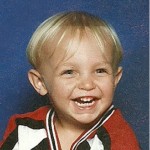 you can call me biased, but I think they are really very good. These days, Caalab and Travis and a couple of friends get together every Wednesday for band practice. It is really fun to sit in the “audience” during practice sessions. It’s always nice to have that talent in your own family.
you can call me biased, but I think they are really very good. These days, Caalab and Travis and a couple of friends get together every Wednesday for band practice. It is really fun to sit in the “audience” during practice sessions. It’s always nice to have that talent in your own family.
With Caalab turning 25 years old, Amy and Travis are taking him to Vegas with their friends Burt and Amy and their kids. It’s going to be a great time. Caalab went to Vegas when he was 21, and they all enjoy going, so it will be fun to go again. They have been planning this for a while now, but Covid stopped it until now. They tend to do well on the slots, so I hope they will win and have a great time. Of course, there is lots to do in Vegas, besides gambling, so I know they will have plenty to do.
Caalab has always been such a happy kid. Always full of smiles, and mischief. He loves a good joke and never 
 forgets the punchline. He is a teaser from way back, something his sister had to learn to accept, and finally agree was funny. Caalab loved being the “funny man” and never missed a chance to make people laugh. He has grown to be a wonderful man, but sometimes I miss the little boy he was, and since he lives far away from me, I miss having him around too. Today is Caalab’s 25th birthday. Happy birthday Caalab!! Have a great day!! We love you!!
forgets the punchline. He is a teaser from way back, something his sister had to learn to accept, and finally agree was funny. Caalab loved being the “funny man” and never missed a chance to make people laugh. He has grown to be a wonderful man, but sometimes I miss the little boy he was, and since he lives far away from me, I miss having him around too. Today is Caalab’s 25th birthday. Happy birthday Caalab!! Have a great day!! We love you!!

 Seventy-five years ago, people began seeing and having an interest in seeing Unidentified Flying Objects (UFOs). A place called Roswell, New Mexico became famous for UFO sightings, and the Air Force found itself denying any sightings. People who saw the UFOs maintained that they “know what they saw!” Roswell, New Mexico is located near the Pecos River in the southeastern part of the state. Roswell became a magnet for UFO believers due to the strange events of early July 1947, when ranch foreman W.W. Brazel found a strange, shiny material scattered over some of his land. It was like nothing he or anyone else had ever seen before.
Seventy-five years ago, people began seeing and having an interest in seeing Unidentified Flying Objects (UFOs). A place called Roswell, New Mexico became famous for UFO sightings, and the Air Force found itself denying any sightings. People who saw the UFOs maintained that they “know what they saw!” Roswell, New Mexico is located near the Pecos River in the southeastern part of the state. Roswell became a magnet for UFO believers due to the strange events of early July 1947, when ranch foreman W.W. Brazel found a strange, shiny material scattered over some of his land. It was like nothing he or anyone else had ever seen before.
I’m not one to believe in UFOs, but I must admit that these were unusual sightings. Public interest in Unidentified Flying Objects, or UFOs, began to flourish in the 1940s, when developments in space travel and the dawn of the atomic age caused many Americans to turn their attention to the skies. Brazel turned the material over to the sheriff, who passed it on to authorities at the nearby Air Force base. Not unexpectedly, the Air Force officials announced they had recovered the wreckage of a “flying disk.” A local newspaper put the story on its front page, launching Roswell into the spotlight of the public’s UFO fascination. I’m sure the newspaper was beyond excited to get the story, because a good story is great for selling newspapers…especially when it is unbelievable.
Of course, in typical government style, the Air Force took back their story, saying the debris had been merely a downed weather balloon. After that, the general public lost interest in the UFO, except for the die-hard UFO believers, nicknamed “ufologists.” With that, the “Roswell Incident” faded into oblivion…until the late 1970s. Then, claims surfaced that the military had invented the weather balloon story as a cover-up. Of course, these would be considered the conspiracy theorists of their day. Believers in this theory insisted that officials had retrieved several alien bodies from the crashed spacecraft, which were now stored in the mysterious Area 51 installation in Nevada. Now, the Air Force had clean-up to do. Seeking to dispel these suspicions, the Air Force issued a 1,000-page report in 1994 stating that “the crashed object was actually a high-altitude weather balloon launched from a nearby missile test-site as part of a classified experiment aimed at monitoring the atmosphere in order to detect Soviet nuclear tests.” Then on June 24, 1997, US Air Force officials release a 231-page report dismissing long-standing claims of an alien spacecraft crash in Roswell, New Mexico, almost exactly 50 years earlier.
Many people have heard this story, of course, and Area 51 remains a mystery to many people to this day. Most think that the whole thing was a hoax or a weather balloon, but now…suddenly, NASA has decided to take up the study of UFOs…seriously!! See, that, to me, seems more like a conspiracy theory or at the very least a way to take our minds off of other events going on in our world today, than it is a legitimate search for UFOs or 
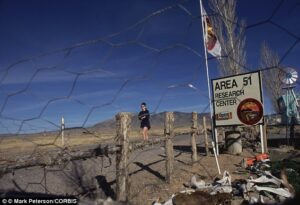 anything else. According to a story by The Sun, on May 27, 2022, “NASA has reportedly confirmed it will officially join the hunt for UFOs after a groundbreaking UAP Congress hearing earlier this month. Unidentified Aerial Phenomena (UAPs) and official sightings were recently discussed at a public US Congress hearing on May 17. Nasa had previously said it “does not actively search for” or research UAPs.” What a way to spend our money…and why now, after all these years.
anything else. According to a story by The Sun, on May 27, 2022, “NASA has reportedly confirmed it will officially join the hunt for UFOs after a groundbreaking UAP Congress hearing earlier this month. Unidentified Aerial Phenomena (UAPs) and official sightings were recently discussed at a public US Congress hearing on May 17. Nasa had previously said it “does not actively search for” or research UAPs.” What a way to spend our money…and why now, after all these years.
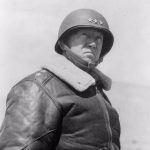 In the final years of World War II, both the Allied and Axis Powers knew that there was no chance of defeating Hitler without cracking his grasp on Western Europe, and both sides knew that Northern France was the obvious target for an amphibious assault. Hitler’s army seemed to be everywhere. That said, the Allied forces knew they had to come up with a way to “fool” the leader of the Third Reich. Hitler arrogantly thought that he knew what the Allied forces were planning, and that was the best way to create his downfall. The German high command assumed the Allies would cross from England to France at the narrowest part of the channel and land at Pas-de-Calais. The Allies used that to their advantage and decided on the beaches of Normandy…some 200 miles to the west. The beaches of Normandy could be taken as they were, but if the Germans added to their defense by moving their reserve infantry and panzers to Normandy from their garrison in the Pas-de-Calais region, the invasion would be a disaster.
In the final years of World War II, both the Allied and Axis Powers knew that there was no chance of defeating Hitler without cracking his grasp on Western Europe, and both sides knew that Northern France was the obvious target for an amphibious assault. Hitler’s army seemed to be everywhere. That said, the Allied forces knew they had to come up with a way to “fool” the leader of the Third Reich. Hitler arrogantly thought that he knew what the Allied forces were planning, and that was the best way to create his downfall. The German high command assumed the Allies would cross from England to France at the narrowest part of the channel and land at Pas-de-Calais. The Allies used that to their advantage and decided on the beaches of Normandy…some 200 miles to the west. The beaches of Normandy could be taken as they were, but if the Germans added to their defense by moving their reserve infantry and panzers to Normandy from their garrison in the Pas-de-Calais region, the invasion would be a disaster.
In what would become an ingenious plan, the Allied intelligence services created two fake armies to keep the Germans on their toes. One would wonder how they proposed to pull that off. The Allies created two “Ghost Armies.” One would be based in Scotland to create a supposed invasion of Norway and the other headquartered 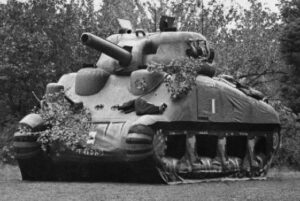 in southeast England to threaten the Pas-de-Calais. While the operation in Scotland relied mainly on fake radio traffic and the feeding of false information to double agents to create the impression of a substantial army, the southern “Ghost Army” had to seem much more real. The fortitude South was well within the range of prying German ears and eyes, so fake chatter alone would be uncovered too quickly. It had to look and sound like a substantial army was building up in southeast England. They needed boots on the ground there, without actually using too much of their precious manpower. That seems like a monumental task.
in southeast England to threaten the Pas-de-Calais. While the operation in Scotland relied mainly on fake radio traffic and the feeding of false information to double agents to create the impression of a substantial army, the southern “Ghost Army” had to seem much more real. The fortitude South was well within the range of prying German ears and eyes, so fake chatter alone would be uncovered too quickly. It had to look and sound like a substantial army was building up in southeast England. They needed boots on the ground there, without actually using too much of their precious manpower. That seems like a monumental task.
Enter George and his imaginary men. Patton was put in charge of leading a fake army, commonly known as the “Ghost Army” as part of a massive counterintelligence operation preceding D-Day. The “Ghost Army” was an army of inflatable tanks, rubber airplanes, and fake radio signals designed to trick the German army. The mission was insanely successful. The “Ghost Army” was a United States Army tactical deception unit used during World War II officially known as the 23rd Headquarters Special Troops. The 1100-man unit was given a 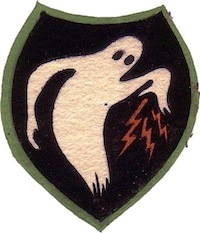 unique mission within the Allied Army. Their orders…impersonate other Allied Army units to deceive the enemy. It was simple, but it wouldn’t be easy.
unique mission within the Allied Army. Their orders…impersonate other Allied Army units to deceive the enemy. It was simple, but it wouldn’t be easy.
By the evening of June 6, 1944, in what would become known as D-Day, the First Army landed at Normandy. The battle was on, and without the extra troops Hitler might have sent if he wasn’t misled so completely. By June 23, 1945, the 23rd Headquarters Special Troops was on its way home after having served with four US armies through England, France, Luxembourg, Belgium, Holland, and Germany. During their tenure, they put on what many would call a “traveling road show” utilizing inflatable tanks, sound trucks, fake radio transmissions, scripts, and pretense. They staged more than 20 battlefield deceptions, often operating very close to the front lines. While their missions and their work were amazing, their story was kept secret for more than 40 years after the war, until it was declassified in 1996.
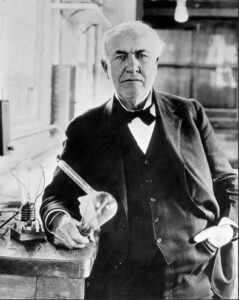
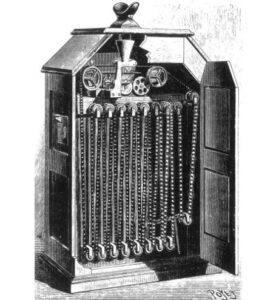 We all think of California, when we think of Hollywood. Of course, these days we also think of politics, and we wish we didn’t have to associate one with the other, because it has ruined the whole theme of Hollywood. Be that as it may, there was a time when Hollywood wasn’t in California. It was in New York. So, what happened?
We all think of California, when we think of Hollywood. Of course, these days we also think of politics, and we wish we didn’t have to associate one with the other, because it has ruined the whole theme of Hollywood. Be that as it may, there was a time when Hollywood wasn’t in California. It was in New York. So, what happened?
The film industry started in 1878, when Eadweard Muybridge first demonstrated the power of photography to capture motion. It was an amazing new concept, and it started the ball rolling to what would become modern-day films. In 1894, the world’s first commercial motion-picture exhibition was given in New York City. This wouldn’t have been possible without Thomas Edison’s kinetoscope. The kinetoscope is an early motion-picture device in which the images were viewed through a peephole. While Edison’s kinetoscope made film possible, it also became a big part of the problem that caused the film industry to make a major move.
Edison had patented his kinetoscope…as he should have, but in all, he had patents on over 1,000 different things. These patents included most of the technology needed to make high-end movies. The Edison Manufacturing Company’s patent lawsuits against each of its domestic competitors crippled the US film industry. The turmoil reduced production mainly to two companies…Edison and Biograph, which used a different camera design. The others had to import French and British films, which was not how anyone wanted things to go. In the end, Edison pretty much put himself out of the industry.
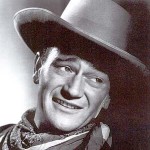
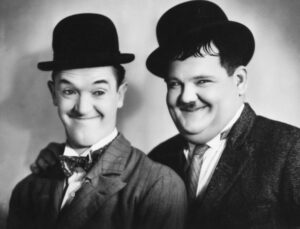 In the following decades, production of silent film greatly expanded. Studios formed and migrated to California, and films and the stories they told became much longer. The main reason for the move to California was to escape the Edison patent lawsuits, but there were other reasons too. It turned out that the milder climate made it easier to finish films, due to better weather. These days, that doesn’t matter so much. What weather patterns can’t be created, can simply be traveled to, so filming can go on year-round.
In the following decades, production of silent film greatly expanded. Studios formed and migrated to California, and films and the stories they told became much longer. The main reason for the move to California was to escape the Edison patent lawsuits, but there were other reasons too. It turned out that the milder climate made it easier to finish films, due to better weather. These days, that doesn’t matter so much. What weather patterns can’t be created, can simply be traveled to, so filming can go on year-round.
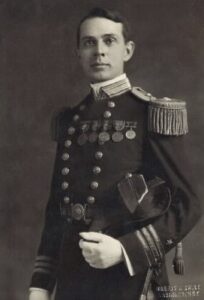 The United States Navy ship USS Knox (FF-1052) was named for Commodore Dudley Wright Knox, who was an officer in the United States Navy during the Spanish-American War and World War I. Born in Fort Walla Walla, Washington, on June 21, 1877, Knox was also a prominent naval historian. For many years he oversaw the Navy Department’s historical office, now called the Naval Historical Center. I can’t say for sure, nor exactly how, but I suspect that Dudley Wright Knox is somehow related to my husband, Bob Schulenberg’s Knox side of the family. That will be a subject I will need to explore further in the future.
The United States Navy ship USS Knox (FF-1052) was named for Commodore Dudley Wright Knox, who was an officer in the United States Navy during the Spanish-American War and World War I. Born in Fort Walla Walla, Washington, on June 21, 1877, Knox was also a prominent naval historian. For many years he oversaw the Navy Department’s historical office, now called the Naval Historical Center. I can’t say for sure, nor exactly how, but I suspect that Dudley Wright Knox is somehow related to my husband, Bob Schulenberg’s Knox side of the family. That will be a subject I will need to explore further in the future.
Knox attended school in Washington DC and graduated from the United States Naval Academy on June 5, 1896. Following his graduation, he served in the Spanish-American War aboard the screw steamer Maple in Cuban waters. A screw steamer or screw steamship is an old term for a steamship or steamboat powered by a steam engine, using one or more propellers…also known as screws…to propel it through the water. These ships were nicknamed iron screw steam ship.
His was a long and distinguished career. During the Philippine-American War, Knox commanded the gunboat Albay, and during the Chinese Boxer Rebellion, the gunboat Iris. He then commanded three of the Navy’s first destroyers…Shubrick, Wilkes, and Decatur. Following his attendance and graduation from the Naval War College in 1912–13, Knox became the aide to Captain William Sims, commanding the Atlantic Torpedo Flotilla. During the cruise of the “Great White Fleet,” he was sent around the world by President Theodore Roosevelt, as an ordnance officer on the battleship Nebraska (BB-14).
He took the lead in developing naval operational doctrine when he published an article of great influence in the US Naval Institute Proceedings in 1915. He was Fleet Ordnance Officer in both the Atlantic and the Pacific, serving in the Office of Naval Intelligence, and commanding the Guantanamo Bay Naval Station. The job of a Fleet Ordnance Officers is to ensure that weapons systems, vehicles, and equipment are ready and available…and in perfect working order, at all times. These officers also manage the developing, testing, fielding, handling, storage, and disposal of munitions. In November 1917, Knox joined the staff of, by then, Admiral William Sims, Commander of US Naval Forces in European Waters. Knox earned the Navy Cross for “distinguished service” while serving as Aide in the Planning Section and later in the Historical Section. He was promoted to Captain on 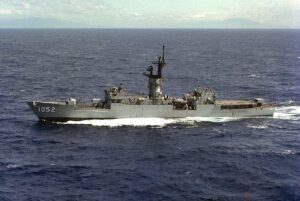 February 1, 1918. In March 1919, Knox returned to the United States. He served for a year on the faculty of the Naval War College, where he was a key figure on the Knox-King-Pye Board that examined professional military education. In 1920–21, he commanded the armored cruiser Brooklyn (ACR-3), then the protected cruiser Charleston (C-22) before resuming duty in the Office of the Chief of Naval Operations.
February 1, 1918. In March 1919, Knox returned to the United States. He served for a year on the faculty of the Naval War College, where he was a key figure on the Knox-King-Pye Board that examined professional military education. In 1920–21, he commanded the armored cruiser Brooklyn (ACR-3), then the protected cruiser Charleston (C-22) before resuming duty in the Office of the Chief of Naval Operations.
Also in 1920, Knox first began his work as a naval publicist, serving as naval editor of the Army and Navy Journal until 1923. He then became the naval correspondent of the Baltimore Sun in 1924 – 1946, and naval correspondent of the New York Herald Tribune in 1929. While he was transferred to the Retired List of the Navy on October 20, 1921, he actually and strangely continued on active duty, serving simultaneously as Officer in Charge, Office of Naval Records and Library, and as Curator for the Navy Department. Knox played a key role in creating the Naval Historical Foundation. Early in World War II, he was assigned additional duty as Deputy Director of Naval History.
In a career that spanned half of a century, Knox’s leadership inspired diligence, efficiency, and initiative while he guided, improved, and expanded the Navy’s archival and historical operations. Knox had personal connections to President Roosevelt, Fleet Admiral Ernest J King, and other senior leaders in the Navy Department. These relationships allowed him to play an instrumental role, albeit behind the scenes in the years leading up to and during World War II.
Knox published a number of writings and several books…including his first book “The Eclipse of American Sea Power” (1922) and “A History of the United States Navy” (1936). “A History of the United States Navy” is recognized as “the best one-volume history of the United States Navy in existence.” Through his personal connection with President Roosevelt, he was able to publish key, multi-volume collections of documents on 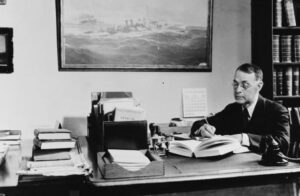 naval operations in The Quasi-War with France in 1798–1800, the first Barbary war and the second Barbary War…stories that may not have been told, had he not taken the initiative.
naval operations in The Quasi-War with France in 1798–1800, the first Barbary war and the second Barbary War…stories that may not have been told, had he not taken the initiative.
November 2, 1945, found Knox promoted to Commodore, and awarded the Legion of Merit for “exceptionally meritorious conduct” while directing the correlation and preservation of accurate records of the US naval operations in World War II, thus protecting this vital information for posterity. Finally, on June 26, 1946, Knox was relieved of all active-duty work. He died in Bethesda, Maryland, on June 11, 1960. His cause of death is listed as unknown. He was 83 years old.
 People have been eating honey since ancient times. The early connoisseurs of honey weren’t beekeepers, but rather foragers. It stands to reason that at some point people were going to want to have their own supply of honey, and with that beekeeping was born. So, how were they going to have a continuing supply of the honey they loved? Enter the apiary. I didn’t know the meaning of an apiary until my 1st cousin once removed, Larry Cameron got into beekeeping. I had never known anyone who was a beekeeper before, but in my opinion, you would have to be brave to do that job…brave or have the right equipment, I guess.
People have been eating honey since ancient times. The early connoisseurs of honey weren’t beekeepers, but rather foragers. It stands to reason that at some point people were going to want to have their own supply of honey, and with that beekeeping was born. So, how were they going to have a continuing supply of the honey they loved? Enter the apiary. I didn’t know the meaning of an apiary until my 1st cousin once removed, Larry Cameron got into beekeeping. I had never known anyone who was a beekeeper before, but in my opinion, you would have to be brave to do that job…brave or have the right equipment, I guess.
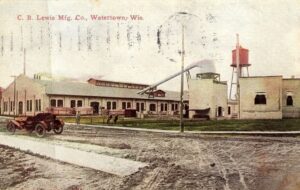
In 1863, a man named G.B. Lewis founded G.B. Lewis Company with the idea of supplying these beekeepers with the necessary beeware to run their businesses. Beeware was a term I really hadn’t heard before, but when I looked it up, it made sense. Beeware, of course, refers to the equipment used by beekeepers. Hives, in 1863, came in three forms…a skep, a log hive, and a box hive. The skep, which was a tightly woven basket, was used the oldest style, but it became obsolete in America, probably because there was plenty of wood to use. G.B. Lewis Company was known for many years as the world’s largest manufacturer of beeware.
Then on April 25, 1890, disaster struck. At 2:30am on that Saturday morning, a huge fire occurred in the city. 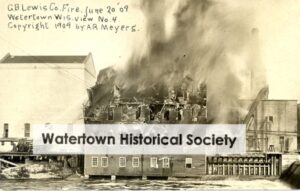 Because the fire was so destructive, it appeared that a large portion of the west side if the city would be destroyed. At G.B. Lewis Company, the entire box, beehive, and section factory was destroyed, along with the Watertown Woolen Mills, owned by Mrs James Chapman. The damage to the G.B. Lewis Company was about $15,000, but it was only insured for $4,500, and at that time there was no guaranteed replacement. Next door to the G.B. Lewis Company and the Watertown Woolen Mills, were two large lumberyards, the Empire flour mills, and several frame buildings. These were apparently saved in the end due to the hard work of the fire department. The origin of the fire is remains unknown to this day.
Because the fire was so destructive, it appeared that a large portion of the west side if the city would be destroyed. At G.B. Lewis Company, the entire box, beehive, and section factory was destroyed, along with the Watertown Woolen Mills, owned by Mrs James Chapman. The damage to the G.B. Lewis Company was about $15,000, but it was only insured for $4,500, and at that time there was no guaranteed replacement. Next door to the G.B. Lewis Company and the Watertown Woolen Mills, were two large lumberyards, the Empire flour mills, and several frame buildings. These were apparently saved in the end due to the hard work of the fire department. The origin of the fire is remains unknown to this day.

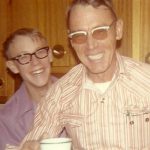 Father’s Day…for me means remembering the two men who were the best dads ever…my dad, Allen Spencer and my father-in-law, Walter Schulenberg. I wish every day that Father’s Day wasn’t about their memories, but that it was rather a day to spend with them. In fact, some stories bring tears, and this is going to be one of them, I guess. It doesn’t really matter how many years your dad has been in Heaven, because there will always be those “ton-of-bricks” moments when the tears just come, no matter what you try to do to stop them.
Father’s Day…for me means remembering the two men who were the best dads ever…my dad, Allen Spencer and my father-in-law, Walter Schulenberg. I wish every day that Father’s Day wasn’t about their memories, but that it was rather a day to spend with them. In fact, some stories bring tears, and this is going to be one of them, I guess. It doesn’t really matter how many years your dad has been in Heaven, because there will always be those “ton-of-bricks” moments when the tears just come, no matter what you try to do to stop them.
I was just so blessed to have two wonderful dads in my life. My dad made sure that we, his five daughters and our mom, had opportunities to see the country, go camping, read maps and plan trips, and so many other things. He taught us responsibility, love for one another, and most importantly, love for God. My father-in-law was much the same kind of man, even though the family didn’t do a lot of traveling. They were still a very close 

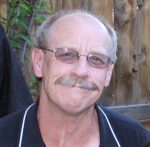 family and helped each other in any way they needed. It was and still is almost a network of people with unique talents who share the load when it comes to needs. These two men, now in Heaven were key influences in my life, and I will always be grateful for them.
family and helped each other in any way they needed. It was and still is almost a network of people with unique talents who share the load when it comes to needs. These two men, now in Heaven were key influences in my life, and I will always be grateful for them.
I also have several other men who are some of the dads in my life. While these men are not my dads, they are part of my family. My husband, Bob Schulenberg…the father of my children, Corrie Petersen and Amy Royce. My sons-in-law, Kevin Petersen and Travis Royce, who have been wonderful husbands and dads to my daughters and grandchildren…who have worked hard to give them happy lives. Then, there are my two grandsons, Chris Petersen who has a daughter and son, and my grandson, Josh Petersen who has a son coming 
 in October…both are actively raising (or soon will be) their children. I am so proud of these men…dads who are with the mothers of their children and are actively raising their families together. They are great role models and loving fathers, and in them we have all been blessed. I also want to recognize all my brothers-in-law and nephews, because they are amazing dads and great blessings too. Today is Father’s Day, and while it must be a memory day for me, it is a special day for all of us. Happy Father’s Day to these and all dads today. Have a great day!!
in October…both are actively raising (or soon will be) their children. I am so proud of these men…dads who are with the mothers of their children and are actively raising their families together. They are great role models and loving fathers, and in them we have all been blessed. I also want to recognize all my brothers-in-law and nephews, because they are amazing dads and great blessings too. Today is Father’s Day, and while it must be a memory day for me, it is a special day for all of us. Happy Father’s Day to these and all dads today. Have a great day!!

